Is This The Highest Paying Travel Nursing Job Ever?
There’s a lot of mystery surrounding how much money travel nurses make. Every now and then, a story pops up describing how some travel nurse somewhere is making hundreds of thousands of dollars per year. Stories like this tend to bolster the belief that travelers make tons of money. These stories also make some travelers wonder if they’re doing something wrong by not earning these fabled amounts. In this blog post, we’ll critically analyze one such story in an effort to decipher the details.
The Travel Nursing Pay Story We’ll Review
Here is a screen shot of the pay story that we’ll be reviewing. We found this story on Facebook. Sure, it’s from 2014 which makes it quite old now. However, we see similar stories pop up every now and then. Therefore, this story is just as relevant now as ever.
Notice how popular it was. It received 99 likes, 205 comments and 15 shares. That’s the thing about social media. These stories spread like wildfire.
Popular Perceptions on Travel Nursing Pay
If you asked a hundred people how much money travel nurses make, you’d probably get a hundred different answers. The uninitiated have a tendency to believe that all travelers make tons of money. For example, it’s fairly common for travel nurses to hear their permanent counterparts say things like, “Well, that’s why they pay you the big bucks!”…insinuating that travelers get paid much more than permanent employees.
At the other end, you’ll find many travel nurses who feel that travel nursing just doesn’t pay like it used to. Some find that the staff nurses they work with are actually making more than the travelers. And some of those who are just beginning to research travel nursing discover that they might actually be losing money by taking the plunge.
We’ve always maintained that how much travel nurses make varies depending on a host of factors. For example, certain states typically pay more than others and if a traveler watches their costs, they can end up making better money than they would in their home state. Moreover, certain assignments pay more than others, especially “rapid response” and “crisis rate” assignments. And then there are assignments that pay much less.
Finally, pay rates are strongly tied to the demand for travel nurses. For example, pay rates took a huge hit between 2009 and 2011 as the number available travel nursing jobs decreased significantly due to the financial crisis. The market came roaring back to the point that in 2016 USA Today proclaimed that we were in the midst of the hottest travel nursing job market in 20 years.
Since then, the market has stayed relatively hot. Sure, we had a period where job orders tanked due to COVID-19. However, the market has come back strong. Bill rates have spiked and higher pay rates are being advertised.
But just how much is a lot? What can travel nurses reasonably expect to make? We answered that question in great detail in a previous blog post in which we included bill rates and sample pay rates for low, mid and high paying assignments. However, every once in a while a story pops up about pay rates so high that everyone’s jaw drops and we understandably get a lot of questions about why our analysis portrays comparatively low pay rates. So let’s take a critical look at our selected story to determine exactly what’s going on.
Stories of Extremely High Nursing Pay
Again, here is the story we’re considering:
So I just had to get this off of my chest and let someone know. So I’m working in California on a tele unit. Most of the nurses on the unit work per diem and live out of state. I met a nurse from Georgia and the other from Florida. They fly out here for 2-3 weeks at a time just to work. The nurse from Georgia showed me her pay stub and she brought home after taxes $21,000 for 2 weeks. Now she did work 172 hours but dang!!! I almost lost my mind!!! I have never seen a nurses paycheck that big. She said right now she’s over the $200,000 mark for the year. Am I doing this travel nursing wrong?!?!? I just had to share.
On the surface, this is certainly a jaw-dropping story. The nurse has made a ton of money and has also worked a ton of hours. In order to fully understand what’s going on here, we need to determine what the hourly rate would have to be to result in this level of pay. Let’s break down the story’s details as they were provided.
First, the story tells us that the net pay on this paycheck was $21,000. That’s the amount after taxes have been taken out. But we need to know the gross pay in order to determine the hourly pay rate. Therefore, we need to work backwards and use the rest of the information to help us out.
For starters, the nurses in the story are working per diem. Technically, this means they aren’t working travel contracts, so they don’t qualify to receive tax-free money. Therefore, we’re going to assume that their housing and other expenses aren’t being paid for and that they’re not receiving tax-free stipends.
Given the fact that all of the income was reported on the same paycheck, we must assume that all of the hours were worked for the same employer. Moreover, I think it’s fair to assume that they work directly for the hospital because I’ve never heard of an agency having bill rates that would support paying this much money. Meanwhile, it’s true that hospitals in California pay their staff per diem nurses pretty well.
For example, I once worked with a traveler who took a per diem job directly with a bay area hospital that paid $68 per hour. The bill rate for travel jobs at the same hospital was $63 per hour.
BluePipes: Professional Networking and Career Management Tools for Healthcare Professionals
Determining the Gross Pay For The Story
With all that in mind, let’s reverse engineer the net pay figure to get the gross pay figure. We’re going to use Paycheck City’s “Gross Up Calculator” to run our numbers. This calculator allows you to enter the net pay along with various other details to determine the gross pay. We ran three sets of numbers through the calculator in order to account for various tax scenarios.
For each scenario we entered net pay of $21,000 for a 2 week period. We also added a “year-to-date pay” amount of $200,000 as indicated by the story. In our first example, we selected “single” as our filing status and we selected zero allowances. This scenario has us paying the maximum amount in taxes. The screen shot is below.
As you can see, the gross pay required to net $21,000 is a whopping $42,355.24. You’ll also notice that nothing was collected for Social Security because the nurse has already exceeded the maximum annual taxable earnings for social security. In our second calculation, we kept everything the same but added 2 allowances. The screen shot is below.
As you can see, the gross pay is still really high at $42,078.10. In our third example, we selected “married” as our filing status and added 2 allowances. The screen shot is below.
As you can see, the gross pay is still really high at $40,948.89. The point is that we can change the tax status and allowances without having a major impact on the gross pay figures. Of course, the person in the story could have claimed that they were exempt from taxes on their W4, in which case they would have to pay taxes on the $21,000 they earned or face a stint in federal prison. However, the story gives the impression that $21,000 is the net pay, so we have to assume the taxes have been paid.
With our gross pay figures all set, we’re ready to determine the hourly pay rates required to earn this kind of money. The simplest thing to do is to determine the average hourly rate. According to the story, the nurse worked 172 hours. Below are the calculations for each of the examples above:
$42,355.24 / 172 hours = $246.25 per hour
$42,078.10 / 172 hours = $244.64 per hour
$40,948.89 / 172 hours = $238.64 per hour
Wow! Those are really high average hourly pay rates relative to what is typically paid to Registered Nurses working on a Telemetry unit in California’s bay area. In fact, it’s fair to say that these rates are at least 300% higher than normal.
Of course, the one thing we don’t know is how the hours broke down on a daily basis. And this makes a difference because some hours would be paid the regular rate, some would be paid time and a half, and some would be paid double time.
However, none of this changes the fact that the hourly pay rates would have to average these amounts in order to total the required gross pay that results in $21,000 of net pay. But let’s take a look at an example to determine just how much the regular hourly pay rate would have to be in order to achieve these pay figures.
What The Regular Hour Rate Would Have To Be
Let’s assume a scenario in which the nurse was able to rack up as much double-time pay as possible in order to achieve this level of pay. Employers are required to pay double-time for every hour worked after 12 in a day in the state of California. So let’s assume the nurse worked 24 hour shifts to accrue 12 hours of double-time per shift.
Now let’s assume that the hospital uses an “alternative work schedule”. In California, this means the hospital pays regular time for the first 12 hours and double time for all hours above 12 in a day. In order to average $240 per hour over a 24 hour shift, the regular hour pay rate would have to be $160 per hour.
Again….wow! $160 per hour is really high relative to what is typically paid to Registered Nurses working on a Telemetry unit in the California bay area.
What If The Nurses Were Getting Paid Tax-Free Money?
It’s difficult to see how a hospital would be able to pay multiple nurses this type of rate and stay in business. Again, the story indicates that “most of the nurses on the unit work per diem”. So, let’s assume that these per diem nurses are somehow being paid tax-free stipends for lodging and Meals & Incidental Expenditures.
Let’s assume this is San Francisco, which has the highest per diem rates in the bay area. And let’s assume that the employer in question is willing to pay the maximum amounts allowed by the IRS for lodging and M&IE. That would be $209 per day for lodging and $71 per day for M&IE. That comes out to $2,926 for lodging and $994 for M&IE for a total of $3,920 for the two week period in question.
That comes to $22.79 per hour in tax-free money over 172 hours. It also reduces the net pay figure to $17,080 for the two week period. So let’s reverse engineer this figure like we did above to determine the gross pay required to achieve this level of net pay. The results from PaycheckCity are below for someone with married status and two allowances.
As you can see, the gross pay is still pretty high at $32,086.13. Below is the equation to calculate the average hourly pay rate over 172 hours.
$32,086.13 / 172 = $186.55 per hour taxable
Remember, we still have to add the value of the tax-free money.
$186.55 + $22.79 = $209.33 per hour total
Even if the hospital was paying tax-free stipends for lodging and M&IE, they’d still be paying an average hourly rate of $209.33 to their per diem registered nurses on their Telemetry unit.
Thoughts on Extremely High Travel Nursing Pay Stories
When I worked as a recruiter, I would receive weekly calls from travelers who were referred to me because they thought they were getting totally ripped off by their current agencies. As a salesman, I should have pounced on these opportunities to get them all working with me. However, that’s just not my style.
Instead, I’d ask probing questions to find out all the details I needed to determine exactly what was going on so I could truly assist the traveler. In some cases, the travelers were indeed getting a pretty bad deal. However, in the vast majority of cases, there was some misunderstanding or some factor that wasn’t being considered, and they were actually getting a good deal, or at least a decent deal.
The point is that it’s important to look at these things critically to determine exactly what’s going on. Work backwards to reverse engineer the numbers. Ask probing questions to get all the details you need to make a fair judgement.
As for this particular story, we’d absolutely love to hear your thoughts and questions. We’d also love to hear if you have similar stories to share. Please post them along with any other questions or comments in the comments section below!



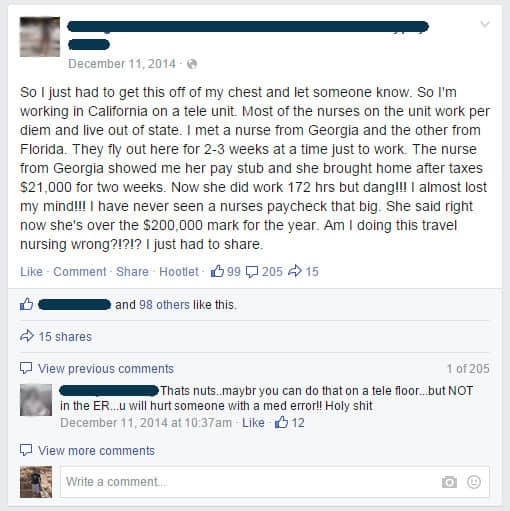
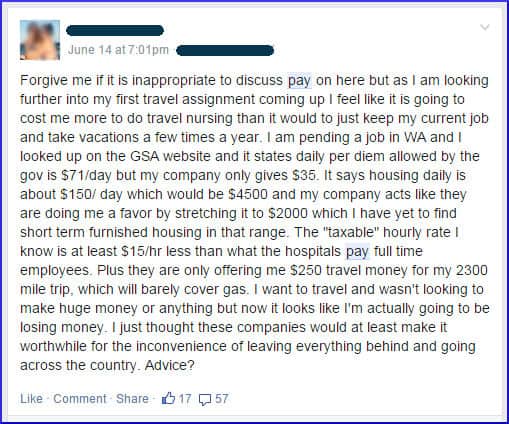

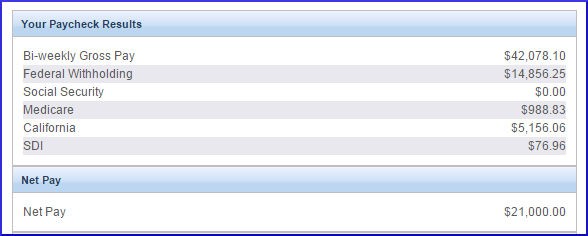
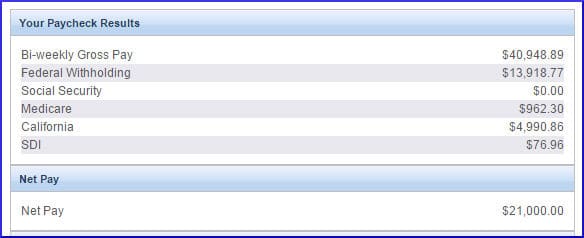
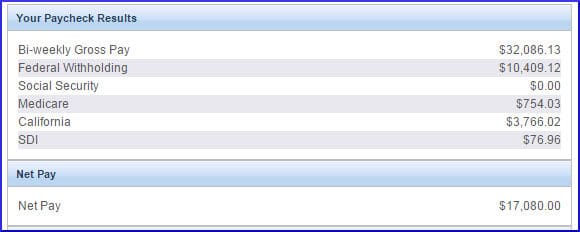


I’ve never made less than $2100 after taxes and medical in the Bay area for 36hr/week contracts. Most travelers I talk to here make between $2000-2500 take home after taxes
Thanks for sharing, Jesse! That sounds about right given the current market. There are currently some contracts that pay less and some that pay a bit more in the Bay Area. At $2100 per week for 36 hours, that’s an average of $58 per hour after taxes. However, the story cited in this article says the traveler made $10,500 after taxes for working 85 hours. That’s $123 per hour which is over double what you’re getting!
Moreover, given that tax free stipends are capped by the GSA, a far greater percentage of this traveler’s pay would have to be taxable…meaning that both the traveler and the agency get taxed on the income. So, while the bill rates for the contracts you cite range between $90 and $120 per hour, the bill rate for the assignment in the story would be anywhere from $200 to to $250 per hour. Plus, the hospital would need to let their nurses work 14 12 hour shifts in a row.
Hello, just a question about my package. $21 x 40 = $840 ($630 after 25% taxes) + $357 meal stipend + $623 housing = $1610/week after 25% taxes I’m a CVOR Tech, this will be for Michigan
Hello, I have a contract in Bay Area with Kaiser. 36hours/week for 13 weeks. per hour: $31.37 for the first 8 hours of 12, then overtime pay for the last 4 hours: $47.07. Meals/day is $35, and Lodging is $64/day. when i calculate my gross a week, it turns out to be just a little above $2000. is this considered a good deal, considering we will be located in oakland,ca?
Yes, this appears to be a good rate for the area. However, the only way to know if you’re getting a good deal for this particular assignment would be to obtain rate quotes from other companies for the same exact assignment. I hope this helps!
Hey Kyle,
I am in the process of considering a travel assignment for South Carolina. The taxable rate is $18/hr; the overtime taxable rate is $65/hr; lodging stipend is $650 per wk, M&IE stipend is $225 per week, with a total travel stipend of 500.00. Medical is $145 a week. I am trying to negotiate an extra time rate of $50/hr. Call pay is $4/hr for being on call. Do you consider this a good contract? I feel that the $18/hr taxable rate is a bit low for SC.
Thanks,
DD
Thanks for the inquiry DD. It’s best to view the taxable rate as just one part of the overall compensation package. By itself, it’s low, but to make it higher, the agency would most likely take money from another compensation variable and add it to the taxable rate. The net affect would be zero. When it comes to taxable hourly rates, the most important thing is to be sure that it’s not so low that it sets off a red flag for the IRS. The IRS doesn’t have a written rule on how much the hourly taxable wage needs to be for a travel RN. However, many tax experts claim the figure should be at $18 to $20 per hour. So, $10 per hour is too low.
You may want to ask what the difference would be between the overtime rate and the extra time rate for this particular agency. Extra time could just be any hours between your contracted hours and South Carolina’s overtime law requirements. For example, if you’re contracted to work 36, and South Carolina requires overtime pay after 40 hours in a week, then extra time might only cover hours 36 through 40 because anything over 40 would be overtime. Or, the agency may consider any hour you work over the contracted hours as overtime, in which case, you don’t need to worry about hours 36-40 because they’ll be paying you $65 per hour. In any case, the “overtime” rate you have is good. Whether or not you try to negotiate a separate extra-time rate will depend on how the agency handles these hours.
If this is a contract for 36 hours per week, then the value of the package not including the travel stipend is $46.02 per hour. The value of the travel stipend assuming 36 hours per week for 13 weeks is $1.06 per hour. Given my experience, this looks good for South Carolina. However, you might want to check around to see what other agencies are offering. One great wat to do this is to check in a facebook group dedicated to travel nursing jobs. Recruiters routinely post pay rates in those groups.
I hope this helps!
My guaranteed contract hours is 36. My taxable rate per hour is $12 and overall stipends $903 plus completion bonus for 13 weeks assignment of 1000 (taxable). Pls tell me if this right. I felt that the hourly rate is so low. Thanks
PS: I am in state of Iowa.
Thanks for the inquiry. Given the details, it appears as though the total blended hourly rate is $39.21. I’m not sure if they are giving you medical benefits, a travel stipend, or any other compensation variables, but if they are, then those should be factored in as well. That said, it’s impossible to know if this is a good rate without knowing the bill rate. However, my experience indicates that this in the ball park for Iowa. Also, the hourly taxable rate is really low from the standpoint of IRS regulations. You may want to review this article on low taxable base rates. I hope this helps!